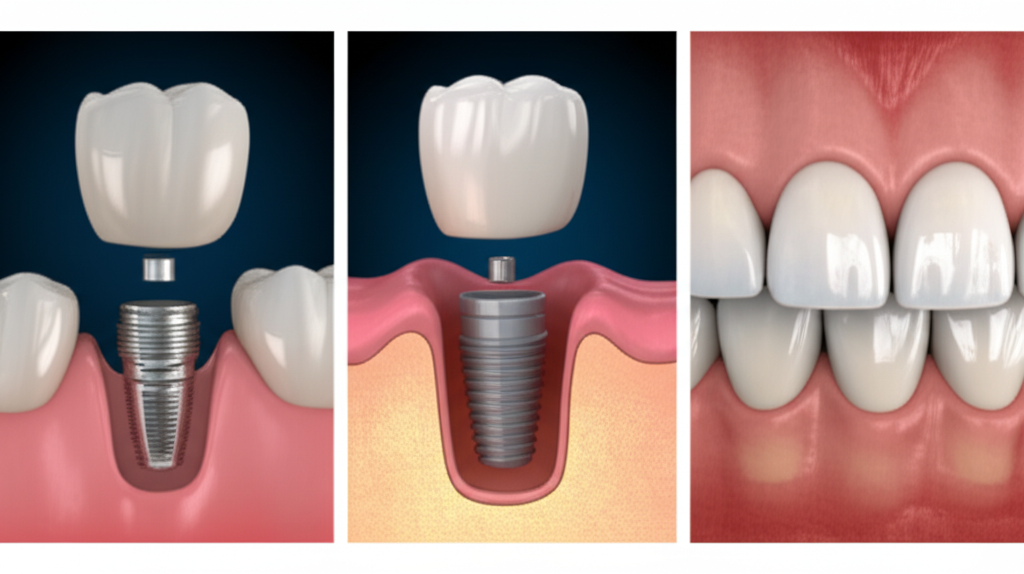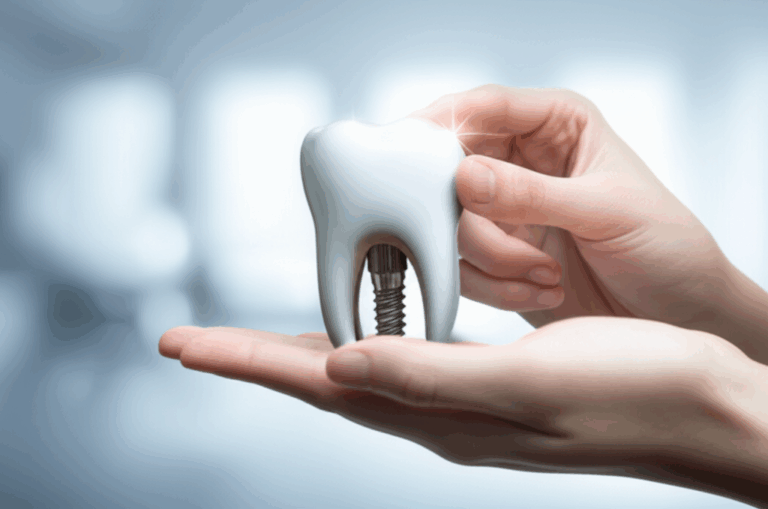
The 3 Main Steps of Dental Implants: An Easy Guide to Your New Smile
Ready to fill that gap from a missing tooth and get your confident smile back? Dental implants are a great choice for a strong, long-term fix. This article will explain the three main steps, what to expect in each one, why they are important, and how you will get a new tooth that looks completely real. If you want to chew, smile, and talk easily again, keep reading!
Table of Contents
- Introduction: Your Path to a Smile That Lasts
- What Are the 3 Steps of Dental Implants?
- Step 1: Check-up, Exam, and Planning
- What Happens During a Dental Implant Exam?
- Who is a Good Candidate for Dental Implants?
- Step 2: Placing the Implant and Healing
- What is Osseointegration and Why is it Important?
- Step 3: Adding the Connector and Final Tooth
- What to Expect After Getting Your Implant Tooth
- How Long Do Dental Implants Last?
- What Problems Can Happen With Dental Implants?
- Dental Implant Success Rates: A Look at the Numbers
- Are You a Good Candidate for a Dental Implant?
- How to Take Care of Dental Implants
- Where to Get High-Quality New Teeth
- Summary: Key Things to Remember
Introduction: Your Path to a Smile That Lasts
Missing teeth can make everyday life tough. I’ve seen many people who had trouble eating food they love or felt self-conscious about their smile. Dental implants are a common solution because they are strong, stay in place, and look like real teeth.
But getting an implant is not a quick fix. It’s a journey that needs time and patience. You can’t rush it, but if you stick with the process, you’ll get a new tooth that could last for the rest of your life. Let’s go over what happens so you know what to expect, from costs and prep to getting better afterward.
What Are the 3 Steps of Dental Implants?
Getting a dental implant is usually done in three main steps—think of it like a project with three key parts:
We’ll look at each step closely and answer your biggest questions along the way.
Step 1: Check-up, Exam, and Planning
Getting a dental implant starts with a meeting between you, your dentist, and maybe an oral surgeon or a prosthodontist (a specialist in tooth replacement).
Why is this first step so important?
This is where the whole plan is made. Your dentist needs to see if implants are right for you and find any issues before the procedure. You’ll talk about your health, what you want your smile to look like, and what will work best for your mouth.
What really happens?
- The dentist will check your jawbone and gums.
- They will use X-rays or even 3D CT scans to get a detailed picture of your mouth.
- They will ask about your health history (for example, if you have diabetes or take certain medicines).
- They will talk about different treatment options—you might need a bone graft or other prep work first.
This step figures out if you can get an implant right away or if you need other dental work done first, like treating gum disease.
What Happens During a Dental Implant Exam?
Imagine you are lying back in the dental chair, maybe feeling a bit nervous. That’s totally normal! The dentist will:
- Check your gums to make sure they are healthy.
- Gently tap or move your teeth to find any unseen issues.
- Take a 3D x-ray or CT scan. These images show how much bone you have and help locate nerves or sinuses.
- Check your bite to see how your top and bottom teeth come together.
These early checks help avoid unexpected problems later on. Sometimes, you might be told you need a sinus lift or ridge augmentation if your jawbone isn’t thick or strong enough. These extra procedures help build more bone so the implant has a solid foundation.
Who is a Good Candidate for Dental Implants?
Not everyone is ready for implants right away. So who makes a good candidate?
- Healthy gums and enough jawbone are a must.
- People over age 18—kids’ jaws are still growing!
- Good overall health: Uncontrolled diabetes or heavy smoking makes it harder to heal after surgery.
- Good oral hygiene habits. Regular brushing, flossing, and dental check-ups keep implants safe from infection.
If you lack bone, don’t panic. Modern dental labs, like an implant dental laboratory, and dental suppliers can now create strong results with bone grafting or advanced materials.
Step 2: Placing the Implant and Healing
You passed the exam and got the okay—now for the big day! During this step, your dentist will place the implant inside your jawbone.
Step-by-step breakdown:
- The dentist gives you local anesthesia (numbing medicine so you don’t feel pain).
- They make a tiny cut in your gum to reach the bone.
- A special drill creates an exact spot for the implant.
- The titanium implant screw (the implant itself) is carefully placed into the jawbone.
- They might put on a healing cap or cover the implant with your gum to protect it.
Afterward, you might feel some swelling or discomfort. Most people say it’s easier than having a tooth pulled!
Here’s a quick comparison table:
| Step | What Happens |
|---|---|
| Anesthesia | Numbs your mouth |
| Incision | Gets to the jawbone |
| Drilling & Placement | Places the implant screw |
| Suturing | Closes gums or adds a healing cap |
You’ll likely get pain medicine and antibiotics to take for a few days.
What is Osseointegration and Why is it Important?
That’s a fancy word for a very important step. After the implant is placed, your jawbone needs to grow around it and fuse with it. This process is called osseointegration, and it’s what locks the implant securely in place.
Why is this so critical?
A dental implant doesn’t have natural roots. It needs your jawbone to hold it firmly. If this fusion doesn’t happen correctly, the implant could become loose or fail.
How long does it take?
It usually takes 3 to 6 months. You might wear a temporary tooth during this time. The wait can feel long, but it’s needed to make sure your new tooth will be strong enough for you to chew and smile with confidence.
Step 3: Adding the Connector and Final Tooth
Once the implant is solid in your jawbone, it’s time for the final step—getting your new tooth!
Here’s what happens:
1. Placing the Abutment—A Small Procedure
- The dentist will make a tiny opening in your gum to get to the top of the implant.
- A small connector piece, called an abutment, is attached to the implant.
- A healing cap might be put on top to help your gums heal in the right shape around it.
2. Checking the Gums and Making a Mold
- After a few weeks, your gums will be healed. The dentist will then take an impression (a mold) of your teeth.
- This mold is sent to a professional crown and bridge lab or dental ceramics lab, where skilled experts make your new tooth.
3. Attaching the Final Tooth
- The new crown (the part that looks like a tooth) is placed on top of the abutment.
- Your dentist will make sure it fits perfectly, matches your other teeth, and feels right when you bite down.
And just like that, you’ll have a new tooth that looks and feels natural!
What to Expect After Getting Your Implant Tooth
Having a new implant tooth might feel a little different at first, but most people love it. Here’s what you can expect:
- Your bite and smile will look natural—no one will know it isn’t real!
- Chewing and speaking will be much easier.
- Implants don’t move or click—they are fixed in your jaw.
- The implant tooth is easy to clean, just like your other teeth.
If you get a full set of new teeth, you might also use removable denture lab services for special cases.
How Long Do Dental Implants Last?
Here’s the good news: Dental implants are made to last. If you take good care of them, the implant post in your jaw can last for 20 years or even a lifetime. The crown on top might need to be replaced after 10-15 years due to normal wear, but that’s a simple fix, not another surgery.
A quick look at how well they work long-term:
- Success rate: 95-98%
- How long they last: 20+ years, often a lifetime
- Most problems: Usually happen early on if the bone doesn’t heal right
Taking care of your implant just like your other teeth is the key to making it last.
What Problems Can Happen With Dental Implants?
Dental implants are very safe, but no procedure is 100% risk-free. Here are a few things to be aware of:
- Peri-implantitis: This is an infection around the implant, similar to gum disease. It can cause swelling or bone loss.
- Infection: This is not common, but it can happen if you don’t clean the area well.
- Nerve or sinus issues: These are very rare and are usually avoided with good planning and scans.
- Smoking: This can make it much harder for your body to heal and doubles the risk of implant failure.
If you have concerns, talk to your dentist about how to avoid these issues, or look into common dental problems for more information.
Dental Implant Success Rates: A Look at the Numbers
Here’s a table with important numbers to help you feel at ease.
| Feature | Statistic/Timeframe |
|---|---|
| Success rate | 95-98% |
| Lasts (with care) | 20+ years / Lifetime |
| Osseointegration period | 3–6 months |
| Bone graft success | 80–90% |
| Complications (peri-implantitis) | 5–10% |
| Immediate implant placement | 85–90% (in special cases) |
| Patient satisfaction | > 95% |
| Risk from smoking | 2× failure rate |
| Healing after extraction (if any) | 2–4 months |
Most people are very happy with their results.
Are You a Good Candidate for a Dental Implant?
Before you get too excited, it’s a good idea to ask yourself a few questions:
People who take good care of their teeth, don’t smoke, and visit their dentist often have the best chance of their implant lasting a lifetime. If you are missing teeth, dental implant procedures are a great way to get your smile back.
How to Take Care of Dental Implants
Clean your implants just like you clean your natural teeth. Here’s how:
- Brush twice a day with a soft toothbrush.
- Floss every day. You can get special floss made for implants.
- Visit your dentist at least two times a year.
- Use a Waterpik to clean hard-to-reach spots.
- Avoid sticky foods and chewing on hard things like ice.
If you grind your teeth at night, a custom mouthguard from a night guard dental lab can protect your new teeth.
Where to Get High-Quality New Teeth
For the best results, the lab that makes your new tooth is very important. Modern dental labs, like a china dental lab, use high-tech tools and experienced staff. They work with your dentist to make custom teeth that look great and fit just right.
These labs use digital design, 3D pictures, and top materials like zirconia and porcelain to make your new tooth match your natural ones. You can be sure that your new smile will be both comfortable and beautiful.
Summary: Key Things to Remember
- Dental implants are a long-term solution for missing teeth.
- Three steps: The check-up, placing the implant, and adding the new tooth.
- Healing takes time—be patient for a great result.
- You need healthy gums and enough bone for it to work.
- Implants can last forever with good care.
Ready to start your dental implant journey? Talk to your dentist, ask all your questions, and make sure they work with a great dental lab so your new smile will last for many years.
References:
- American Academy of Implant Dentistry
- Long-term dental implant outcome studies
- Published dental research on osseointegration, bone grafting, and implant survival rates
- Clinical guidance from oral surgery and prosthodontic specialists








